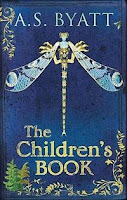This time last year the IHR was preparing to host the conference Novel approaches: from academic history to historical fiction. The conference covered such areas as the transition of historians from writing history to writing historical fiction; the differences and similarities between historical fiction and academic history; the popularity of historical fiction; and the need, or not, to be historically correct. Quite by chance, while checking the Journal of Victorian Culture, I noticed a Roundtable on A.S. Byatt’s The Children’s Book. The novel is set during the period 1895-1919 and follows the dramas of a number of inter-related families connected with the children’s author Edith Nesbit and can be considered to be part of the popular neo-Victorian fiction. The Roundtable could happily have been part of the IHR conference.
The Roundtable is introduced by Joseph Bristow and is followed by Katharina Uhsadel, who places the novel within Byatt’s career and the attention to historical detail in the book. Diana Maltz examines the socialist/Fabian subculture comparing the lead character Olive Wellwood to Nesbit’s real life. Morna O’Neill then examines the ways in which the Victoria and Albert museum, art exhibitions and art movements of the time are portrayed. Finally, Margaret D. Stetz considers the representation of death in Byatt’s novel.

The Journal of Victorian Culture also runs a strand entitled “Digital Forums” – a useful series of articles highlighting a particular digital resource or use of such resources. The latest issue discusses the “Nineteenth-century newspapers in the digital age”. Areas covered include the current provision of digital resources of newspapers and the types of research they facilitate, while the other papers discuss the quantitative methodologies known collectively as ‘distant reading’. Previous Digital Forums have covered the use of digital resources in the classroom, crime and Victorian reading habits.
A forthcoming Digital Forum looks at social media in the history community.
